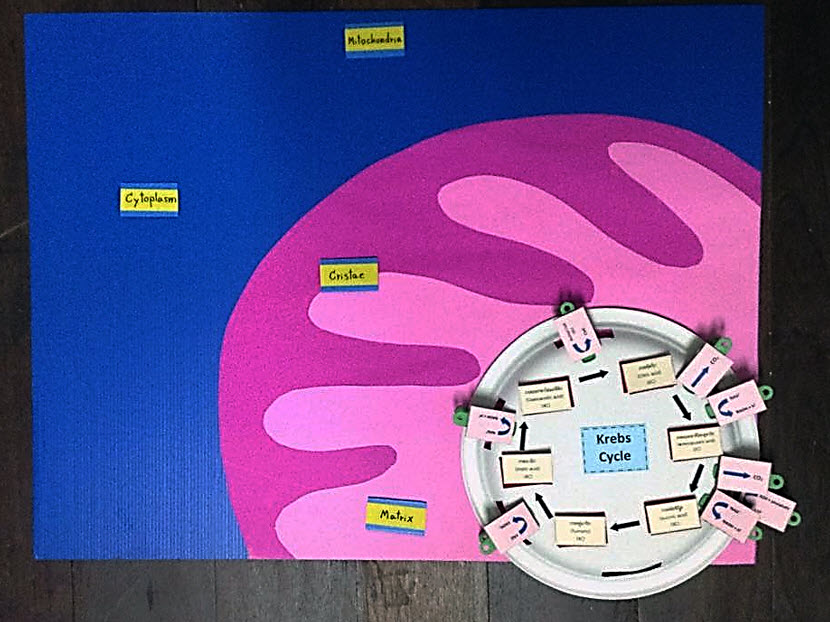การเรียนรู้วัฏจักรเครบส์ในการสลายสารอาหารระดับเซลล์ด้วยการสืบเสาะวิทยาศาสตร์: กิจกรรมการลงมือปฏิบัติ (hands-on) เพื่อยกระดับผลสัมฤทธิ์ทางการเรียน
Main Article Content
Abstract
Learning Kreb’s Cycle in Cellular Respiration through Science Inquiry: A Hands-on Activity for Improving Academic Achievement
Supaporn Porntrai
รับบทความ: 21 มิถุนายน 2559; ยอมรับตีพิมพ์: 3 ตุลาคม 2559
บทคัดย่อ
งานวิจัยนี้มีวัตถุประสงค์เพื่อพัฒนากิจกรรมการเรียนรู้แบบสืบเสาะวิทยาศาสตร์เรื่องวัฏจักร เครบส์ในการสลายสารอาหารระดับเซลล์ และศึกษาประสิทธิภาพและประสิทธิผลของกิจกรรมด้านผลสัมฤทธิ์ทางการเรียน ระเบียบวิธีวิจัยประกอบด้วยการพัฒนากิจกรรมการเรียนรู้และแบบวัดผลสัมฤทธิ์ทางการเรียน และการนำไปใช้กับกลุ่มตัวอย่างซึ่งได้แก่นักเรียนชั้นมัธยมศึกษาปีที่ 4 จำนวน 2 ห้องเรียน ห้องเรียนละ 35 คน เก็บข้อมูลจาก 1) แบบวัดผลสัมฤทธิ์ทางการเรียนก่อนเรียน-หลังเรียนชนิดเลือกตอบ 4 ตัวเลือก จำนวน 6 ข้อ และ 2) ใบงานและแบบจำลองที่นักเรียนสร้าง กิจกรรมการเรียนรู้แบบสืบเสาะวิทยาศาสตร์นี้ประกอบด้วย 5 ขั้น ขั้นที่ 1 นักเรียนจดจ่อกับคำถามที่จะนำไปสู่การสืบเสาะ ขั้นที่ 2 นักเรียนเก็บข้อมูลเพื่อสร้างเป็นหลักฐานที่เกี่ยวเนื่องกับคำถาม ขั้นที่ 3 นักเรียนสร้างคำอธิบายทางวิทยาศาสตร์จากประจักษ์พยานที่ค้นพบ ขั้นที่ 4 นักเรียนเชื่อมโยงคำอธิบายไปยังองค์ความรู้ทางวิทยาศาสตร์ และขั้นที่ 5 นักเรียนสื่อสารและโต้แย้งแสดงเหตุผลสนับสนุนผลการค้นพบของตนเอง ใช้เวลาในการจัดกิจกรรม 90 นาที ผลการวิจัยพบว่า ห้องเรียนที่ 1 กิจกรรมการเรียนรู้นี้มีค่าประสิทธิภาพ (E1/E2) และค่าดัชนีประสิทธิผล (E.I.) เท่ากับ 81.79/80.48 และ 0.7462 ตามลำดับ นักเรียนมีความ ก้าวหน้าทางการเรียนคิดเป็นร้อยละ 74.62 (<g> = 0.74) จัดเป็นความก้าวหน้าในระดับสูง และนักเรียนยกระดับผลสัมฤทธิ์ทางการเรียนจากระดับไม่ผ่านเกณฑ์ขั้นต่ำ (22.38%) ไปสู่ระดับดีเยี่ยม (80.48%) ซึ่งเป็นการเพิ่มขึ้นอย่างมีนัยสำคัญทางสถิติ (p < .05) ส่วนห้องเรียนที่ 2 กิจกรรมการเรียนรู้นี้มีค่า E1/E2 และค่า E.I. เท่ากับ 81.43/80.95 และ 0.7452 ตามลำดับ นักเรียนมีความก้าวหน้าทางการเรียนคิดเป็นร้อยละ 74.52 (<g> = 0.74) จัดเป็นความก้าวหน้าในระดับสูง ทำให้นักเรียนยกระดับผลสัมฤทธิ์ทาง การเรียนจากระดับไม่ผ่านเกณฑ์ขั้นต่ำ (21.90%) ไปสู่ระดับดีเยี่ยม (80.95%) ซึ่งเป็นการเพิ่มขึ้นอย่างมีนัยสำคัญทางสถิติ (p < .05)
คำสำคัญ: วัฏจักรเครบส์ การสลายสารอาหารระดับเซลล์ การสืบเสาะวิทยาศาสตร์ กิจกรรมการลงมือปฏิบัติ ผลสัมฤทธิ์ทางการเรียน
Abstract
This research aimed to develop a science inquiry-based learning activity in topic of Krebs’ cycle in cellular respiration and study its efficiency and effectiveness on academic achievements. Research methodology composed of developing learning activity and achievement test, and introducing the activity to the samples which were 2 classrooms of 10th grade students (35 students each class). Data were collected from: 1) pre-post academic achievement test which was 6 items of 4 multiple choices test, and 2) work sheets and students’ constructed models. This science inquiry-based learning activity was comprised of 5 steps: step 1, student engages in scientifically oriented questions; step 2, student gives priority to evidence in responding to question; step 3, student formulates explanations from evidence; step 4, student connects explanations to scientific knowledge; step 5, student communicates and justifies explanation. All steps were completed in 90 minutes. The results showed that for the first classroom, the efficiency (E1/E2) and effectiveness (E.I.) of this activity were 81.79/80.48 and 0.7462, respectively. The students’ learning progression was 74.62% (<g> = 0.74), categorized as a high gain level. The students improved their pre-academic achievement from a low level (22.38%) to an excellent level for post-academic achievement (80.48%) which was a statistically significant increasing (p < .05). For the second classroom, the E1/E2 and E.I. were 81.43/80.95 and 0.7452, respectively. The students’ learning progression was 74.52% (<g> = 0.74), categorized as a high gain level. The students improved their pre-academic achievement from a low level (21.90%) to an excellent level for post-academic achievement (80.95%) which was a statistically significant increasing (p < .05).
Keywords: Kreb’s cycle, Cellular respiration, Science inquiry, Hands-on activity, Academic achievement
Downloads
Article Details

This work is licensed under a Creative Commons Attribution-NonCommercial 4.0 International License.
References
Baiya, S., and Phornphisutthimas, S. (2014). The construction of a hands-on laboratory practical on “cellular respiration” for undergraduate learners. The 1st National Conference on Science Education to Inspire Innovation (pp.244–248). Phetchaburi: Rajabhat Phetchaburi University.
Boomer, S. M., and Latham, K. L. (2011). Manipulatives-based laboratory for majors biology a hands-on approach to understanding respiration and photosynthesis. Journal of Microbiology and Biology Education 12(2): 127–134.
Briggs, B., Mitton, T. and Magnuson, T. (2009). Teaching cellular respiration & alternate energy sources with a laboratory exercise developed by a scientist-teacher partnership. The American Biology Teacher 71(3): 164–167.
Dunlap, D., and Patrick, P. (2012). The beads of translation: using beads to translate mRNA into a polypeptide bracelet. The American Biology Teacher 74(4): 262–265.
Hake, R. R. (1998). Interactive-engagement versus traditional methods: a six-thousand-student survey of mechanics test data for introductory physics courses. American Journal of Physics 66(1): 64–74.
Hussain, M., and Akhtar, M. (2013). Impact of hands-on activities on students’ achievement in science: An experimental evidence from Pakistan. Middle-East Journal of Scientific Research 16(5): 626–632.
McDonald, G. (2012). Teaching critical and analytical thinking in high school biology. The American Biology Teacher 74(3): 178–181.
Ministry of Education. (2012). Basic Education Core Curriculum B.E. 2551. Bangkok: Agriculture Cooperatives of Thailand Printing. (in Thai)
Mungmad, A., and Porntrai, S. (2011). Developing of achievement in learning cellular respiration for Muttayomsuksa 4 students using an instructional package with co-operative Learning. The Proceeding of the 12th Graduate Research Conference (pp.1472–1478). Khon Kaen: Khon Kaen University. (in Thai)
National Research Council [NRC]. (2000). Inquiry and the National Science Education Standards: A Guide for Teaching and Learning. Washington DC: National Academy.
Ozcan, T., Yildirim, O., and Ozgur, S. (2012). Determining of the university freshmen students’ misconceptions and alternative conceptions about mitosis and meiosis. Procedia 46: 3677–3680.
Phochaiyarach, S., and Porntrai, S. (2015). Enhancing analytical thinking abilities using science inquiry approach. Journal of Research on Science, Technology and Environment for Learning 6(1): 46–56. (in Thai)
Porntrai, S. (2015). Learning cell cycle and mitosis by science inquiry: An active way to increase academic achievement and knowledge retention. Journal of Research on Science, Technology and Environment for Learning 6(2): 175–187. (in Thai)
Prasertsan, S. (2012). Research-based Project: New Learning Process for Thai Education. Bangkok: Thailand Research Fund. (in Thai)
Promwong, C. (2013). Developmental testing of media or teaching package’s efficiency. Silpakorn Educational Research Journal 5(1): 7–20. (in Thai)
Romero, C., and Choun, J. (2014). The Electron transport chain: An interactive simulation. The American Biology Teacher 76(7): 456–458.
Ross, P. M., Tronson, D. A., and Ritchie, R. J. (2008). Increasing conceptual understanding of glycolysis and the Krebs cycle using role play. The American Biology Teacher 70(3): 163–168.
Songer, C. J., and Mintzes, J. J. (1994). Understanding cellular respiration: An analysis of conceptual change in college biology. Journal of Research in Science Teaching 31(6): 321–637.
Wu, H., and Hsieh, C. (2006). Developing sixth grades’ inquiry skills to construct explanations in inquiry-based learning environments. International Journal of Science Education 28(11): 1289–1313.
